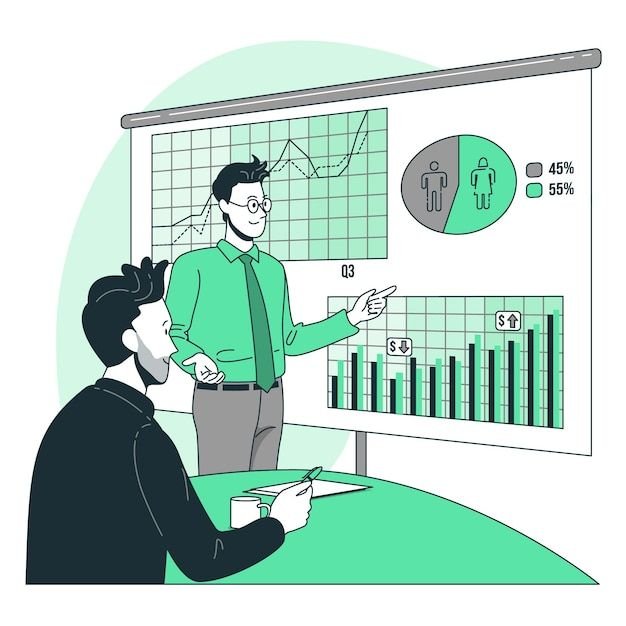In today’s rapidly evolving business environment, data-driven decision-making has become more critical than ever. Business analytics, the practice of using data and statistical methods to gain insights and inform business decisions, is at the forefront of this transformation. As technology continues to advance, the future of business analytics is poised to be even more dynamic and impactful. This blog explores the key trends and developments that are shaping the future of business analytics.
1. Artificial Intelligence and Machine Learning Integration
One of the most significant trends shaping the future of business analytics is the integration of artificial intelligence (AI) and machine learning (ML). These technologies are enabling businesses to analyze vast amounts of data more quickly and accurately than ever before. AI-powered analytics can identify patterns and trends that might be missed by traditional methods, offering deeper insights and more predictive capabilities. As AI and ML continue to evolve, their role in business analytics will only grow, leading to more intelligent and automated decision-making processes.
2. Real-Time Analytics
In a world where businesses need to respond to changes in the market rapidly, real-time analytics is becoming increasingly important. Traditional analytics often involve analyzing historical data, but real-time analytics allows businesses to make decisions based on current data. This shift is particularly crucial in industries like retail, finance, and healthcare, where immediate decisions can have a significant impact. The future will likely see more businesses adopting real-time analytics to stay competitive and responsive to market demands.
3. Data Democratization
As business analytics tools become more user-friendly, there is a growing trend toward data democratization. This means that more employees, regardless of their technical expertise, will have access to analytical tools and data. The future of business analytics will likely involve a more decentralized approach, where data-driven insights are accessible to all levels of an organization, fostering a culture of data literacy and empowering employees to make informed decisions.
4. Predictive and Prescriptive Analytics
While descriptive analytics focuses on what has happened in the past, predictive analytics uses historical data to forecast future outcomes. Prescriptive analytics goes a step further by recommending actions based on predictive models. The future of business analytics will see a rise in these advanced analytics techniques, helping businesses not only understand what might happen but also determine the best course of action to achieve desired outcomes. This shift will lead to more proactive and strategic decision-making.
5. Big Data and Cloud Computing
The explosion of big data is another factor driving the future of business analytics. With the proliferation of data from various sources—social media, IoT devices, customer interactions—businesses have more information than ever to analyze. Cloud computing is playing a crucial role in managing and processing this data, providing scalable solutions that enable businesses to handle large datasets efficiently. The future will likely see continued growth in big data analytics, with cloud-based platforms offering even more sophisticated tools for data analysis.
6. Enhanced Data Privacy and Security
As data becomes more integral to business operations, concerns about data privacy and security are also on the rise. The future of business analytics will involve greater emphasis on ensuring that data is collected, stored, and analyzed in compliance with stringent privacy regulations. Advanced encryption methods, secure data storage solutions, and robust data governance frameworks will become increasingly important to protect sensitive information and maintain customer trust.
7. Personalized Customer Experiences
One of the most exciting prospects for the future of business analytics is the ability to deliver highly personalized customer experiences. By leveraging data on customer behavior, preferences, and interactions, businesses can tailor their offerings to meet individual needs. This level of personalization can lead to increased customer satisfaction, loyalty, and ultimately, better business outcomes. As analytics tools become more sophisticated, the ability to provide personalized experiences will become a key differentiator for businesses.
8. The Rise of Data Visualization
Data visualization tools are becoming more advanced, making it easier for businesses to interpret complex data. The future will see the rise of more interactive and intuitive visualization techniques that allow decision-makers to explore data in real-time. These tools will help businesses quickly identify trends, anomalies, and opportunities, making data-driven insights more accessible and actionable.
Conclusion
The future of business analytics is bright, with emerging technologies and trends set to revolutionize how businesses operate and make decisions. From AI and machine learning to real-time analytics and personalized customer experiences, the landscape of business analytics is evolving rapidly. To stay competitive, businesses must embrace these changes and invest in the tools and skills needed to harness the full potential of their data. As the field continues to advance, those who are able to adapt and innovate will be well-positioned to thrive in the data-driven world of tomorrow.





